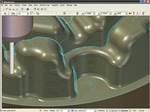How to Lengthen Tool Life with CAM Software Moves
Long tool life is a combination of three elements: the tooling used the way it’s designed to be used; the holder to contain that tool as rigidly as possible; and how the programming software is applied
CAM software, as it relates to tool life, does two things: it controls the tool motion and the entry and exit of the workpiece material. The traditional way of driving machines using older algorithms have been superseded by newer tool motion using advanced algorithms—a technique that removes large amounts of material quickly using a dynamic milling motion that constantly adjusts the toolpath, ensuring the most efficient cut possible. It allows use of the entire flute length of the cutting tool, often eliminating multiple depth cuts. Large, aggressive cuts are followed by fast, smaller up-cuts. A single toolpath can cut material in two directions: on step-downs (-Z) and step-ups (+Z), which removes the maximum amount of material with the minimum of step-downs, significantly reducing cycle times and leaves the part closer to near net shape for subsequent finishing operations.
Likewise new finishing techniques blend two efficient cutting techniques in a single toolpath. This toolpath evaluates the model and smoothly switches between constant Z cutting and constant scallop machining. The result is a finer finish, less work, and less tool wear. Other new dynamic milling techniques help promote tool efficiency during cleanup routines. Another uses high-speed contouring to remove material along walls. It supports multi-passes and can include finishing passes where it determines there is more stock to remove. Newer CAM software seems to truly “understand” where the stock is and the best way to remove it to avoid cutting tool abuse.
How you enter and exit material has a profound effect on tool life. Using the older toolpaths, machinists would often come straight into the material. That entry has tremendous impact on the tool and shortens its life. That shock causes micro fissures and cracks. The best practice now is to come in with an arc motion. It’s a gentler way of initiating the approach and cut.
Turning operations also have new toolpaths that are helping users get the most out of their turning/grooving tools. There are gains in efficiency and surface finish, and the user also attains the benefit of completing an area using only one tool versus two or three tools.
When it comes time to finishing certain cutting tool/insert combinations are designed to flex which allows the insert to cut on a single point with a little more than the corner radius of the insert engaging the material. This effect creates a situation similar to using an insert with wiper geometry and creates a superior finish.
Is it time to put some of these new techniques into action in your mold shop? The future holds that CAM developers will continue to bring true value to their customers and develop their software with life-extending aspects of tooling technology.
Related Content
-
The Secrets to Hard Milling Success
The Secrets to Hard Milling Success
-
It Starts With the Part: A Plastic Part Checklist Ensures Good Mold Design
All successful mold build projects start with examining the part to be molded to ensure it is moldable and will meet the customers' production objectives.
-
The Ins and Outs of Hot Runner Temperature Control
A training checklist that explains the why and how of proper hot runner temperature control and system management.















